E-commerce is quickly shaping up to be the preferred way of doing business for emerging brands and brands that have previously maintained a steadfast offline presence. Today, everything is sold online, from groceries to pharmaceuticals, financial services to education, and consumer goods to luxury items.
As customers are learning to buy different products and services online, their expectations for variety, convenience, and service are also increasing. With the exponential growth in market demand, e-commerce companies are establishing new marketing and sales channels.
At the same time, efforts are being made to achieve operational efficiencies that can elevate the customer experience while adding to the bottom line. To maintain an omnichannel presence in the market, e-commerce providers have to set up multiple warehouses and manage a complicated value chain.
Factors to Consider When Selecting Multiple Warehouse Management In E-commerce
This is impossible to do manually, and thus, there is an undeniable need for an online multi-warehouse management system that can automate several aspects of warehouse management system (WMS). But before opting for a multiple warehouse management system, certain key factors must be considered.
1. Centralization of Multi Warehouse Inventory Management
Automated inventory synchronization across warehouses can enable you to manage orders and multi-channel distribution pipelines with better efficacy. Therefore, first and foremost, the multi-warehouse management system of your choice should offer you a centralized view and control of your inventory.
Not only should the inventory turnover of each SKU (Stock Keeping Unit) in your multiple warehouses be accounted for, excessive stock and stock-out situations should be duly recorded and notified. Centralized control can allow you to route stock from overstocked locations to stock-out locations, ensuring minimal order delays and cancellations due to operational inefficiencies.
2. Real-Time and Customizable Reporting
Next, you need real-time information access about what’s going on in your warehouse network to manage stock inventory effectively. You require a bird’s eye view of which stock units are in demand and which haven’t moved at all, geographic market-specific demand variations, and seasonal trends. You should also be able to generate customizable reports to analyze inventory status and strategize warehouse utilization.
An online multi warehouse management system can enable you to achieve this, as the information remains remotely accessible and available in real-time. Furthermore, you should also be able to run day-to-day operations with dynamic dashboards and reports.
3. Shipping and Logistics Integration
A significant percentage of the operational cost for your e-commerce business comes from shipping and logistics. Therefore, another critical factor that can boost multiple warehouse management is how well your system integrates with shipping and logistics aggregators. In doing so, you can capitalize on their existing logistic network and shipping efficiencies without over-extending your resources.
Furthermore, strategic integration between warehouse and logistics can increase your order fulfillment efficiency and reduce duplication of information within the system.
4. Virtual Multiple Warehouse Inventory Management
Unutilized or under-utilized warehouse space increases your inventory carrying cost and burdens your value chain, even when you have a network of multiple warehouses to match market demand. You need a multi-warehouse management system that gives you a complete virtual view of warehouse space to facilitate space planning and allocation.
Inventory thus stocked can have better visibility and accessibility. At the same time, your order processing time can go down significantly, leading to delightful customer experiences.
5. Accountability and Quality Control
The stock maintained in multiple warehouses and logistics pipelines is susceptible to damage, theft, and obsolescence. And customers who unsuspectingly receive such stock would be forced to return the product and walk away with a negative experience with your brand. This is where the vitality of frequent quality checks and quality control standards comes in to maintain your inventory health.
With barcode or QR code-based inventory management, this can be easily implemented across multiple warehouses at minimal additional cost. You can easily avoid fulfilling orders with defective or damaged stock and replace the same with quality stock. If multiple warehouse inventory management software can do this for you, you can save millions in returns and passive inventory value loss.
6. Returns and Exchange Management
Products returns and exchange is an inevitable part of the e-commerce business, which, if left unchecked, can dramatically reduce sales and operational performance. Therefore, you need a multi-warehouse inventory management system to regularize the returns and exchange process.
There should be a systematic log of returned or exchanged products, their dispatch and receipt warehouse locations, and subsequent actions taken. At the same time, you should be receiving customer behavior insights that can minimize product returns in the long term.
In sum, you can ensure that your multiple warehouse network is optimally managed by considering these factors before opting for any multiple warehouse inventory management software. Through smart automation, reporting, and integration, you can use multiple warehouse management to boost e-commerce sales as well as consistently deliver on your brand’s promise.
Related read –
- How does Warehouse Management System Works?
- Healthcare Industry in India – Growth Drivers, Challenges, Solutions
- Role of Warehouse Management in the FMCG Industry in India
- E-commerce Apparel Industry: Trends, Challenges, Opportunities & Solutions
- UniShip – Advanced Shipping Tracking Platform
- UniReco – E-commerce Marketplace Payment Reconciliation
- Key Challenges & Benefits of Marketplace Payment Reconciliation
- Benefits of Shipping Notifications
- E-commerce Shopify Integration with Unicommerce
- Why Pick List is Important for Warehouse Operations?
- What is Inventory Cycle Counting?
- Logistics vs Supply Chain Management: Key Components, Benefits, Comparison


